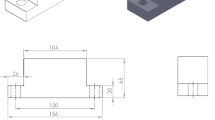Abstract
This paper details the studies on the use of single mesh size garnet abrasives in abrasive waterjet machining for cutting aluminum. The influence of three different single mesh size abrasives, pressure, traverse rate, and abrasive flow rate; on depth of cut, top kerf width, bottom kerf width, kerf taper, and surface roughness are investigated. Experiments designed using standard L9 orthogonal array and the analysis of variance helped in the determination of highly significant, significant and weakly significant cutting parameters. Single mesh size abrasives are found to yield decreased surface roughness than multi mesh size abrasives. Based on these studies, response equations are developed to predict the target parameters. Using single mesh abrasives, a practitioner not only can cut faster but also achieve reduced surface roughness.
Similar content being viewed by others
References
Hashish M (1998) Waterjet advances in field and factory. Proceedings of 5th Pacific Rim International Conference on Waterjet Technology, New Delhi, India 231–246
Hashish M (1984) A modelling study of metal cutting with abrasive water jets. Transactions of ASME Journal of Engineering for Industry 106:88–100
Louis H (1998) Abrasive waterjets: A Review. Proceedings of 5th Pacific Rim International Conference on waterjet technology, New Delhi, India 321–329
Momber A, Kovacevic R (1988) Principles of abrasive waterjet machining. Springer –Verlag, London
Hashish M (1991) Optimisation factors in abrasive waterjet machining. Transactions of ASME Journal of Engineering for Industry 113:29–37
Momber A, Pfeiffer, Kovacevic R, Schunemann (1996) The Influence of abrasive grain size distribution parameters on the abrasive waterjet machining process. Proceedings of the 1996 24th NAMRI conference, Society of Manufacturing Engineers MR96(115):1–6
Momber A, Kovacevic R (2000) Particle size distribution influence in high speed erosion of aluminium. Particle Science and Technology 18:199–212
Labus T, Neusen K, Alberts D, Gores T (1991) Factors influencing the particle size distribution in an abrasive waterjet. Transactions of the ASME, Journal of Engineering for Industry 113:402–411
Krishnaiah Chetty OV, Ramesh Babu N (1999) Some investigations on abrasives in abrasives waterjet machining. Proceeding of 10th American waterjet conference, Waterjet Technology Association, USA: 419–430
Kantha Babu M, Krishnaiah Chetty OV (2001) Studies on the use of local abrasives in abrasive waterjet machining. Proceedings of 17th International conference on CAD/CAM, Robotics and Factories of Future, Durban, South Africa: 150–156
Kantha Babu M, Krishnaiah Chetty OV (2001) Abrasive waterjet machining of aluminium with local abrasives. Proceedings of 11th American WaterJet Conference, WaterJet Technology Association, Minneapolis, USA: 325–341
Guo N, Louis H, Meier G, Ohlsen J (1992) Recycling capacity of abrasives in Abrasive WaterJet cutting. Proceedings of 11th International conference on Jet Cutting Technology, Scotland 503–523
Hashish M (1989) A model for abrasive waterjet machining. Transactions of the ASME, Journal of Engineering Materials and Technology 111:154–162
Matsumoto K, Arasawa H, Yamaguchi S (1998) A study of the effect of abrasive material on cutting with abrasive waterjet. Proceedings of 9th International symposium of jet cutting technology, Sendai, Japan 255–269
Kantha Babu M, Krishnaiah Chetty OV (2002) Studies on recharging of abrasives in abrasive waterjet machining. International Journal of Advanced Manufacturing Technology, Springer-Verlag, London 19:697–703
Kantha Babu M, Krishnaiah Chetty OV (2003) A study on recycling of abrasives in abrasive waterjet machining. International Journal of Wear, Elsevier Science, Ireland 254:763–773
Kantha Babu M, Krishnaiah Chetty OV (2003) Studies on abrasive waterjet machining of black granite through design of experiment. International Journal of Experimental Techniques, September: 49–54
Kantha Babu M, Krishnaiah Chetty OV (2002) Abrasive waterjet machining of black Granite with garnet abrasives. Journal of the Institution of Engineers, Calcutta, India 83:7–14
Montgomery DC (1991) Design and Analysis of Experiments. John Wiley & Sons Inc, Singapore
Hashish M (1988) Visualisation of the abrasive-waterjet cutting process. Experimental Mechanics 28:159–168
Kovacevic R (1991) Surface texture in abrasive waterjet cutting. Journal of Manufacturing systems 10:32–40
Park SH (1996) Robost Design and Analysis for Quality Engineering, Chapman & Hall, London
Ross PJ (1996) Taguchi Techniques for Quality Engineering, Mcgraw-Hill Int. Editions, Singapore
William YF, Creveling CM (1995) Engineering methods for Robust Product design, Addison- Wesley Publishing Company, Massachusetts
Roslund J (1988) How to perform a Designed Experiments (DOE). International Journal of Experimental Techniques, April: 31–34
Rani RM, Seshan S (1988) Studies on abrasive jet machining through statistical design of Experiments. International Journal of Experimental Techniques, April: 28–30
Hashish M (1991) Characteristics of surfaces machined with abrasive waterjet. Transactions of the ASME Journal of Engineering Materials and Technology 113:354–362
Hashish M (1989) Pressure effects in abrasive waterjet (AWJ) machining. Transactions of ASME Journal of Engineering Materials and Technology 111:221–228
Author information
Authors and Affiliations
Corresponding author
Rights and permissions
About this article
Cite this article
Kantha Babu, M., Krishnaiah Chetty, O. A study on the use of single mesh size abrasives in abrasive waterjet machining. Int J Adv Manuf Technol 29, 532–540 (2006). https://doi.org/10.1007/s00170-005-2536-x
Received:
Accepted:
Published:
Issue Date:
DOI: https://doi.org/10.1007/s00170-005-2536-x




